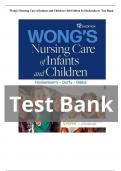Wong's6Nursing6Care6of6Infants6and6Children612th6Edition6by6Hockenberry6Test6Bank
,Chapter601:6Perspectives6of6Pediatric6Nursing
Hockenberry:6Wong’s6Nursing6Care6of6Infants6and6Children,612th6
Edition
MULTIPLE6CHOICE
1. What6is6the6major6cause6of6death6for6children6in6the6United6States?
a. Heart6disease
b. Childhood6cancer
c. Injuries
d. Congenital6anomalies
ANS:6 C
Unintentional6injuries6(accidents)6are6the6leading6cause6of6death6after6age616year6through6adolescence.6
The6leading6cause6of6death6for6those6younger6than616year6is6congenital6anomalies,6and6childhood6cance
rs6and6heart6disease6cause6a6significantly6lower6percentage6of6deaths6in6children6older6than616 year6of6age
.
DIF: Cognitive6Level:6Understanding
TOP:6Nursing6Process:6Planning6MSC:6 Client6Needs:6Health6Promoti
on6and6Maintenance
2. Parents6of6a6hospitalized6toddler6ask6the6nurse,6“What6is6meant6by6family-
centered6care?”6The6nurse6should6respond6with6which6statement?
a. Family-centered6care6reduces6the6effect6of6cultural6diversity6on6the6family.
b. Family-centered6care6encourages6family6dependence6on6the6health6care6system.
c. Family-centered6care6recognizes6that6the6family6is6the6constant6in6a6child’s6life.
d. Family-centered6care6avoids6expecting6families6to6be6part6of6the6decision-
making6process.
ANS:6 C
The6three6key6components6of6family-centered6care6are6respect,6collaboration,6and6support.6Family-
6centered6care6recognizes6the6family6as6the6constant6in6the6child’s6life.6The6family6should6be6enabled6a
nd6empowered6to6work6with6the6health6care6system6and6is6expected6to6be6part6of6the6decision-
making6process.6The6nurse6should6also6support6the6family’s6cultural6diversity,6 not6reduce6its6effect.
DIF: Cognitive6Level:6Applying
TOP:6Nursing6Process:6Implementation6MSC:6 Client6Needs:6Health6Promoti
on6and6Maintenance
3. Evidence-based6practice6(EBP),6a6decision-making6model,6is6best6described6as6which?
a. Using6information6in6textbooks6to6guide6care
b. Combining6knowledge6with6clinical6experience6and6intuition
c. Using6a6professional6code6of6ethics6as6a6means6for6decision6making
d. Gathering6all6evidence6that6applies6to6the6child’s6health6and6family6situation
ANS:6 B
EBP6helps6focus6on6measurable6outcomes;6the6use6of6demonstrated,6effective6interventions;6and6questi
oning6the6best6approach.6EBP6involves6decision6making6based6on6the6integration6of6the6best6research6ev
idence6combined6with6clinical6expertise6and6patient6values.
,Wong's6Nursing6Care6of6Infants6and6Children612th6Edition6by6Hockenberry6Test6Ban
k
DIF: Cognitive6Level:6Remembering
TOP:6Nursing6Process:6Planning6MSC:6 Client6Needs:6Safe6and6Effect
ive6Care6Environment
4. The6nurse6is6talking6to6a6group6of6parents6of6school-age6children6at6an6after-
school6program6about6childhood6health6problems.6 Which6statement6 should6the6nurse6include6in6th
e6teaching?
a. Childhood6obesity6is6the6most6common6nutritional6problem6among6children.
b. Immunization6rates6are6the6same6among6children6of6different6races6and6ethnicity.
c. Dental6caries6is6not6a6problem6commonly6seen6in6children6since6the6introduction6of6fl
uorinated6water.
d. Mental6health6problems6are6typically6not6seen6in6school-
age6children6but6may6be6diagnosed6 in6adolescents.
ANS:6 A
When6teaching6parents6of6school-
age6children6about6childhood6health6problems,6the6nurse6should6include6information6about6childhood6o
besity6because6it6is6the6most6common6problem6among6children6and6is6associated6with6type626diabetes.6
Teaching6parents6about6ways6to6prevent6obesity6is6important6to6include.6Immunization6rates6differ6depe
nding6on6the6child’s6race6and6ethnicity;6dental6caries6continues6to6be6a6common6chronic6disease6in6child
hood;6and6mental6health6problems6are6seen6in6children6as6young6as6school6age,6not6 just6 in6adolescents.
DIF: Cognitive6Level:6Applying
TOP:6Integrated6Process:6Teaching/Learning6MSC:6 Client6Needs:6Health6Promoti
on6and6Maintenance
5. The6nurse6is6planning6care6for6a6hospitalized6preschool-
aged6child.6Which6should6the6nurse6plan6to6ensure6atraumatic6care?
a. Limit6explanation6of6procedures6because6the6child6is6preschool6aged.
b. Ask6that6all6family6members6leave6the6room6when6performing6procedures.
c. Allow6the6child6to6choose6the6type6of6juice6to6drink6 with6the6administration6of6oral6m
edications.
d. Explain6that6EMLA6cream6cannot6be6used6for6the6morning6lab6draw6because6there6i
s6not6time6for6it6to6be6effective.
ANS:6 C
The6overriding6goal6in6providing6atraumatic6care6is6first,6do6no6harm.6Allowing6the6child,6a6choice6of6
juice6to6drink6when6taking6oral6medications6provides6the6child6with6a6sense6of6control.6The6preschool6
child6should6be6prepared6before6procedures,6so6limiting6explanations6of6procedures6would6increase6a
nxiety.6The6family6should6be6allowed6to6stay6with6the6child6during6procedures,6minimizing6 stress.
Lidocaine/prilocaine6(EMLA)6cream6is6a6topical6local6anesthetic.6The6nurse6should6plan6to6use6the6prescrib
ed6cream6in6time6for6morning6laboratory6draws6to6minimize6pain.
DIF: Cognitive6Level:6Applying
TOP:6Nursing6Process:6Planning6MSC:6 Client6Needs:6Health6Promoti
on6and6Maintenance
6. Which6situation6denotes6a6nontherapeutic6nurse–patient–family6relationship?
a. The6nurse6is6planning6to6read6a6favorite6fairy6tale6to6a6patient.
b. During6shift6report,6the6nurse6is6criticizing6parents6for6not6visiting6their6child.
c. The6nurse6is6discussing6with6a6fellow6nurse6the6emotional6draw6to6a6certain6patient.
d. The6nurse6is6working6with6a6family6to6find6ways6to6decrease6the6family’s6dependenc
e6on6health6care6providers.
, Wong's6Nursing6Care6of6Infants6and6Children612th6Edition6by6Hockenberry6Test6Ban
k
ANS:6 B
Criticizing6parents6for6not6visiting6in6shift6report6is6nontherapeutic6and6shows6an6under6involvement6w
ith6the6parents.6Reading6a6fairy6tale6is6a6therapeutic6and6age-
appropriate6action.6Discussing6feelings6of6an6emotional6draw6with6a6fellow6nurse6is6therapeutic6and6sh
ows6a6willingness6to6understand6feelings.6Working6with6parents6to6decrease6dependence6on6health6car
e6providers6is6therapeutic6and6helps6to6empower6the6family.
DIF: Cognitive6Level:6Analyzing
TOP:6Integrated6Process:6Caring6MSC:6 Client6Needs:6Psychosocial6I
ntegrity
7. The6nurse6is6aware6that6which6age-
group6is6at6risk6for6childhood6injury6because6of6the6cognitive6characteristic6of6magical6and6egoc
entric6thinking?
a. Preschool
b. Young6school6age
c. Middle6school6age
d. Adolescent
ANS:6 A
Preschool6children6have6the6cognitive6characteristic6of6magical6and6egocentric6thinking,6meaning6they6
are6unable6to6comprehend6danger6to6self6or6others.6Young6and6middle6school-
aged6children6have6transitional6cognitive6processes,6and6they6may6attempt6dangerous6acts6without6detai
led6planning6but6recognize6danger6to6themselves6or6others.6Adolescents6have6formal6operational6cogniti
ve6processes6and6are6preoccupied6with6abstract6thinking.
DIF: Cognitive6Level:6Understanding
TOP:6 Nursing6Process:6Assessment6MSC:6 Client6Needs:6Safe6and6Effect
ive6Care6Environment
8. The6school6nurse6is6assessing6children6for6risk6factors6related6to6childhood6injuries.6Which6child6has6
the6most6 risk6factors6related6to6childhood6injury?
a. Female,6multiple6siblings,6stable6home6life
b. Male,6high6activity6level,6stressful6home6life
c. Male,6even6tempered,6history6of6previous6injuries
d. Female,6reacts6negatively6to6new6situations,6no6serious6previous6injuries
ANS:6 B
Boys6have6a6preponderance6for6injuries6over6girls6because6of6a6difference6in6behavioral6characteristics,6
a6high6activity6temperament6is6associated6with6risk-
taking6behaviors,6and6stress6predisposes6children6to6increased6risk6taking6and6self-
destructive6behaviors.6Therefore,6a6male6child6with6a6high6activity6level6and6living6in6a6stressful6enviro
nment6has6the6highest6number6of6risk6factors.6A6girl6with6several6siblings6and6a6stable6home6life6is6low6r
isk.6A6boy6with6previous6injuries6has6two6risk6factors,6but6an6even6temper6is6not6a6risk6factor6for6injuries.
6A6girl6who6reacts6negatively6to6new6situations6but6has6no6previous6serious6 illnesses6 has6only6one6risk6 f
actor.
DIF: Cognitive6Level:6Analyzing
TOP:6 Nursing6Process:6Assessment6MSC:6 Client6Needs:6Safe6and6Effect
ive6Care6Environment
9. An6adolescent6patient6wants6to6make6decisions6about6treatment6options,6along6with6his6parents.6Which6
moral6value6is6the6nurse6displaying6when6supporting6the6adolescent6to6make6decisions?
a. Justice




